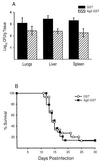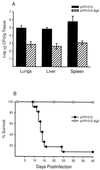Genetic vaccination against Coccidioides immitis: comparison of vaccine efficacy of recombinant antigen 2 and antigen 2 cDNA
- PMID: 9916069
- PMCID: PMC96365
- DOI: 10.1128/IAI.67.2.630-635.1999
Genetic vaccination against Coccidioides immitis: comparison of vaccine efficacy of recombinant antigen 2 and antigen 2 cDNA
Abstract
Previous studies from our laboratory established that C-ASWS, an alkali-soluble, water-soluble extract from cell walls of Coccidioides immitis, protects mice against lethal challenge with this fungus. The C-ASWS extract contains a glycosylated protein, designated antigen 2 (Ag2), and a polysaccharide antigen. We recently cloned Ag2 cDNA and showed that the recombinant fusion protein elicited strong delayed-type hypersensitivity responses in immunized mice. This investigation was undertaken to determine if the recombinant Ag2 protein, expressed as an Ag2-glutathione S-transferase (GST) fusion protein, or Ag2 cDNA would protect mice against lethal challenge with C. immitis. The recombinant Ag2-GST protein protected BALB/c mice against intraperitoneal challenge with 250 arthroconidia, as assessed by a decrease in fungal CFU in tissues. The Ag2-GST-immunized mice did not show, however, an increased survival during a 30-day period postinfection. By contrast, immunization of mice with Ag2 cDNA ligated into the pVR1012 plasmid engendered protection against intraperitoneal challenge with 2,500 arthroconidia and against pulmonary challenge with 50 arthroconidia. Vaccine efficacy paralleled the development of delayed-type hypersensitivity responses to C. immitis antigen. Whereas mice vaccinated with the recombinant Ag2-GST protein did not mount footpad hypersensitivity to C-ASWS or the recombinant Ag2-GST protein, mice vaccinated with the pVR1012-Ag2 construct mounted a strong footpad hypersensitivity and their spleen cells secreted gamma interferon upon in vitro stimulation with the Ag2-containing C-ASWS extract. This is the first investigation to show that genetic immunization can protect against lethal challenge with C. immitis.
Figures




Similar articles
-
Role of signal sequence in vaccine-induced protection against experimental coccidioidomycosis.Infect Immun. 2002 Jul;70(7):3539-45. doi: 10.1128/IAI.70.7.3539-3545.2002. Infect Immun. 2002. PMID: 12065493 Free PMC article.
-
Coadministration of interleukin 12 expression vector with antigen 2 cDNA enhances induction of protective immunity against Coccidioides immitis.Infect Immun. 1999 Nov;67(11):5848-53. doi: 10.1128/IAI.67.11.5848-5853.1999. Infect Immun. 1999. PMID: 10531239 Free PMC article.
-
Localization within a proline-rich antigen (Ag2/PRA) of protective antigenicity against infection with Coccidioides immitis in mice.Infect Immun. 2002 Jul;70(7):3330-5. doi: 10.1128/IAI.70.7.3330-3335.2002. Infect Immun. 2002. PMID: 12065470 Free PMC article.
-
Coccidioidomycosis: host response and vaccine development.Clin Microbiol Rev. 2004 Oct;17(4):804-39, table of contents. doi: 10.1128/CMR.17.4.804-839.2004. Clin Microbiol Rev. 2004. PMID: 15489350 Free PMC article. Review.
-
Antigenic structure of Coccidioides immitis.Immunol Ser. 1989;47:133-70. Immunol Ser. 1989. PMID: 2490076 Review.
Cited by
-
Role of signal sequence in vaccine-induced protection against experimental coccidioidomycosis.Infect Immun. 2002 Jul;70(7):3539-45. doi: 10.1128/IAI.70.7.3539-3545.2002. Infect Immun. 2002. PMID: 12065493 Free PMC article.
-
Coadministration of interleukin 12 expression vector with antigen 2 cDNA enhances induction of protective immunity against Coccidioides immitis.Infect Immun. 1999 Nov;67(11):5848-53. doi: 10.1128/IAI.67.11.5848-5853.1999. Infect Immun. 1999. PMID: 10531239 Free PMC article.
-
Advances in combating fungal diseases: vaccines on the threshold.Nat Rev Microbiol. 2007 Jan;5(1):13-28. doi: 10.1038/nrmicro1537. Epub 2006 Dec 11. Nat Rev Microbiol. 2007. PMID: 17160002 Free PMC article. Review.
-
Attempts at a peptide vaccine against paracoccidioidomycosis, adjuvant to chemotherapy.Mycopathologia. 2008 Apr-May;165(4-5):341-52. doi: 10.1007/s11046-007-9056-1. Mycopathologia. 2008. PMID: 18777638 Review.
-
Role of B cells in vaccine-induced immunity against coccidioidomycosis.Infect Immun. 2005 Oct;73(10):7011-3. doi: 10.1128/IAI.73.10.7011-7013.2005. Infect Immun. 2005. PMID: 16177382 Free PMC article.
References
-
- Ampel N. In vitro production of tumor necrosis factor-α by adherent human peripheral blood mononuclear cells incubated with killed coccidioidal arthroconidia and spherules. Cell Immunol. 1994;153:248–255. - PubMed
-
- Ampel N M, Bejarano G C, Salas S D, Galgiani J N. In vitro assessment of cellular immunity in human coccidioiodmycosis: relationship between dermal hypersensitivity, lymphocyte transformation, and lymphokine production by peripheral blood mononuclear cells from healthy adults. J Infect Dis. 1992;165:710–715. - PubMed
Publication types
MeSH terms
Substances
Grants and funding
LinkOut - more resources
Full Text Sources
Other Literature Sources
Medical
Research Materials
Miscellaneous

